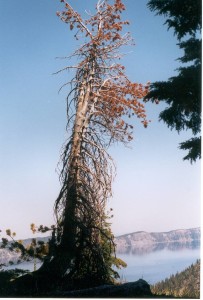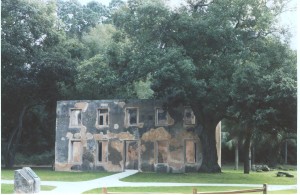Americans love their National parks and expect the National Park Service to ensure the parks’ natural resources are protected “unimpaired for future generations” – as is required by the Service’ founding law.
Despite these expectations, the National Park Service does not take obvious actions to protect trees in the parks from non-native tree-killing insects and plant diseases.
Horton House plantation ruins, Jekyll Island, GA. (Photo by F.T. Campbell) The two large redbay trees shading the house are now gone, killed by laurel wilt. Use your favorite web browser to see how stark the house is now, denuded of its trees.
At historic sites ranging from Horton House plantation on Jekyll Island, Georgia to the Presidio in San Francisco, trees that create atmosphere & maintain visible links to the past have died.
Even more important is the damage occurring to forests in the “crown jewel” wilderness parks:
• Whitebark pines at high elevations of Yellowstone, Glacier, and Crater Lake National parks have been killed by white pine blister rust (see photo below, of dead whitebark pine at Crater Lake). Photo by F.T. Campbell

• The forests of Great Smoky Mountains and Shenandoah National parks, already damaged by chestnut blight, hemlock woolly adelgid, beech bark disease, and gypsy moth, are now losing their ash trees to the emerald ash borer and their walnut trees to thousand cankers disease.
• Everglades National Park and Big Cypress National Preserve are losing their swamp bay trees to laurel wilt
• Tanoak trees in Muir Woods, Redwood National Park, and Pt. Reyes National Seashore have been killed by sudden oak death
• Ash trees in Sleeping Bear Dunes National Lakeshore in Michigan have been killed by the emerald ash borer.
Forests in other “crown jewel” parks are not yet under attack, but are threatened by nearby pests:
• The black oak trees of Yosemite National Park’s signature Valley are at risk to goldspotted oak borer, which has killed more than 100,000 trees in San Diego county.
The threat is obvious … yet the National Park Service dropped efforts to develop a strategy for addressing it. And the NPS has not adopted a national policy requiring campers to obtain their firewood either in the Park or from nearby vendors.
As explained on the Don’t Move Firewood website, firewood is a highly dangerous commodity, since it can transport tree-killing pests to new, vulnerable areas [see also the report Fading Forests III. Some National parks – including Great Smoky Mountains and Shenandoah – have adopted regulations prohibiting visitors from bringing firewood from long distances. However, other parks – including Yosemite – only ask visitors to avoid bringing firewood. In all cases, the firewood regulation or appeal is buried deep within the park’s website. On a more positive note, campers who reserve a campground on such federal websites as www.reserve.gov receive warnings about firewood when they finalize their reservation.
The National Park Service has developed a Manual providing guidance to park managers that describes the threat from firewood and laws and regulations that relate to natural resource protection. However, the Service has left the decision whether to take action to the individual parks’ superintendents.
I think that such a passive stance betrays the Service’ statutory obligation, as laid out in the Organic Act of 1916: the purpose of the National Park Service is
“to conserve the scenery and the natural and historic objects and the wild life therein and to provide for the enjoyment of the same in such manner and by such means as will leave them unimpaired for the enjoyment of future generations.” [emphasis added]
Next year, the National Park Service celebrates its Centenary. I think it should celebrate this anniversary by adopting regulations requiring visitors to obtain firewood locally and finalizing a strategy for combating tree-killing pests.
